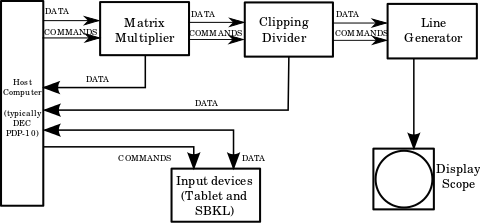LDS-1 (Line Drawing System-1)
LDS-1 (Line Drawing System-1) was a calligraphic (vector, rather than raster) display processor and display device created by Evans & Sutherland. This was the first graphics device with a graphics processing unit.[1]
Features

It was controlled by a variety of host computers. Straight lines were smoothly rendered in real-time animation. General principles of operation were similar to the systems used today: 4x4 transformation matrices, 1x4 vertices. Possible uses included flight simulation (in the product brochure there are screenshots of landing on a carrier), scientific imaging and GIS systems.
History
The first LDS-1 was shipped to the customer (BBN) in August 1969. Only a few of these systems were ever built. One was used by the Los Angeles Times as their first typesetting/layout computer. One went to NASA Ames Research Center for Human Factors Research. Another was bought by the Port Authority of New York to develop a tugboat pilot trainer for navigation in the harbor. The MIT Dynamic Modeling had one, and there was a program for viewing an ongoing game of Maze War. [2][3]
See also
- Case Western Reserve University § Computing, where Project Logos had an LDS-1.
References
- Evans, David C (March 1971). "Graphical Man-Machine Communications (semi-annual technical report for 1 July 1970 to 31 December 1971" (PDF). Defense Advanced Research Projects Agency.
- http://www.digibarn.com/history/04-VCF7-MazeWar/stories/lebling.html
- https://www.polygon.com/features/2015/5/21/8627231/the-first-first-person-shooter